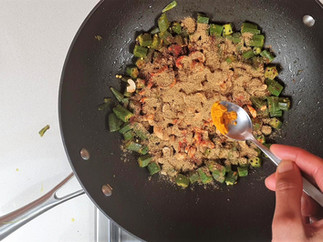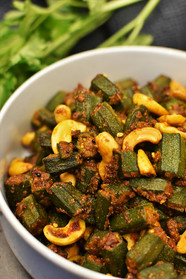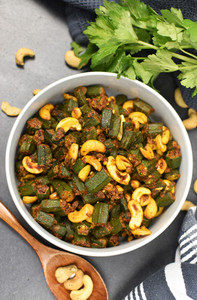
Stand out from the crowd by making this distinctive Kaju Bhindi subji. Make it using frozen bhindi when fresh ones are difficult to locate.
Whenever I serve this subji to my guests, they fall in love with the kaju bhindi (cashew-okra) combo right away. Many compliments and requests for the recipe begin to pour in.
Who doesn't enjoy being praised? I say, keep them coming. But do you know what part of the praise is my hidden favourite? The look on people's faces when they hear I used frozen bhindi in the dish. The expression on their faces is priceless. The perplexed look, half-dropped jaw, standing in silence with wide eyes speaking out loud in their mind "Have you lost your marbles? Is it possible to have frozen bhindi? "Repeat...frozen bhindi...?" and the actual word that comes out is "WOW". Now that is why I enjoy experimenting with food.
I know, I know, what you are thinking. Why use frozen bhindi if we can obtain fresh ones readily? Well, my friends, you're lucky and I envy you. In Australia though, bhindi is not widely cultivated. As a result, they're hard to come by. Even if they are, they are usually large, tough, and have thick fibres. Cooking and eating it isn't really pleasurable. So I buy frozen bhindi that is easily available in Indian supermarkets and are imported from India.
Make this recipe and amaze your loved ones and watch their faces light up.
Guess what? This recipe is also available as a video. Yes, indeed!! Click on the link
Continue reading for tips and stages of making the recipe, or skip to the written version of the recipe Regal Kaju Bhindi Subji
Here are basic ingredients that are easily found in every (Q)kitchen to make Regal Kaju Bhindi Subji.

Frozen Bhindi (Okra / Ladyfingers), Cashews (split into halves), Cooking Oil, Mustard (Rai) Seeds, Cumin (Jeera) Seeds, Turmeric powder, Kashmiri chilli powder, Garam Masala, Corriander powder, Garam Masala, Salt.
Stages of Making - 5 Simple steps
1. Roasting Cashews
Heat up cooking oil in the wok. Make sure the oil is warm, not scorching hot since we do not want to burn cashews. Instead, we want to lightly roast them to eliminate any moisture. constantly stir the cashews on medium flame until they crisp up and turn pale pink.
Collect the roasted cashews on a separate dish for later use, and keep the extra oil in the wok to finish cooking the subji in the following step
2. Tempering Bhindi
Add mustard seeds and cumin seeds to the remaining heated oil and let them splutter.
Thereafter, add the turmeric powder. Add the frozen bhindi as soon as the turmeric begins to sizzle.
3. Stir and cook bhindi until moisture and sliminess disappears
Keep two easy but crucial suggestions in mind at this point: Reduce the heat to low to medium, and never cover the bhindi while cooking.
This will help preserve the deep green colour of the bhindi and ensure that it cooks properly without turning mushy.
Toss the bhindi in the prepared temper to evenly coat it. Continue to mix and cook the bhindi for another 5 minutes on low heat. You will witness distinct stages of bhindi transformation throughout this cooking time. Bhindi will begin to thaw first, then release a liquid that will create slimy strands (see the pic below). Because we're using frozen bhindi, it is likely to produce more liquid and become slimier before drying up. Don't worry, when the liquid evaporates, the sticky threads will reduce as well. When this happens, it means the bhindi is done and it's time to move on to the next phase of the process.
Have you noticed that I've left out the salt? Normally, salt is used to aid speed up the cooking process, but this is not the case with bhindi. Salt will cause the bhindi to release more liquid, making it more sticky and resulting in a gooey subji. So please hold off on adding salt till the bhindi is free of water and stickiness.
4. Add all the spices and seasoning
This is the stage when you add the rest of the ingredients and spices. Roasted cashews, chilli powder, garam masala, coriander powder, turmeric, and salt (yes, finally salt) goes in.
5. Mix, cook, and serve
Combine all of the ingredients thoroughly and sauté for a few minutes on low heat, or until the spices no longer have a raw flavour. Remove from the heat and serve.
Final result
Now, tell me honestly, doesn't this subji flaunt a regal vibe?
Is it the same process to cook with fresh bhindi?
Fresh bhindi would work well in this subji. Make sure you choose tender ones and follow all of the recommendations I've provided.
Can any other nuts be instead of cashews?
Cashews are the perfect nut to serve with bhindi since they are soft and don't overpower the dish. So are Macadamia nuts. Almonds can be used, but they must be blanched and skinned before being added to the subji. Other nuts, such as walnuts, pecans, and hazelnuts, should be avoided since they have a strong bitter nutty flavour that will dominate the bhindi flavour. If you do not mind little sweetness then add 1 tbsp of raisins (sultanas).
Can Kaju Bhindi subji be made ahead of time?
Without a doubt. You may prepare it a few hours ahead of time, or even a day in advance. Refrigerate it and reheat it shortly before serving.
Storage and Shelf life?
This dish is so simple and quick to prepare that you won't want to preserve it and instead prepare it just before your mealtime. However, if you have a busy schedule and want to plan your meals ahead of time, you may keep them in the refrigerator for 2-3 days or the freezer for a month.
Add cashews for a royal touch to bhindi, while spices for a depth of flavour.
Recipe Video below
Recipe link below



































































Thank you Niti for a very yummy Kaju bhindi receipe 💕